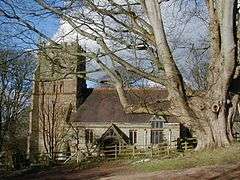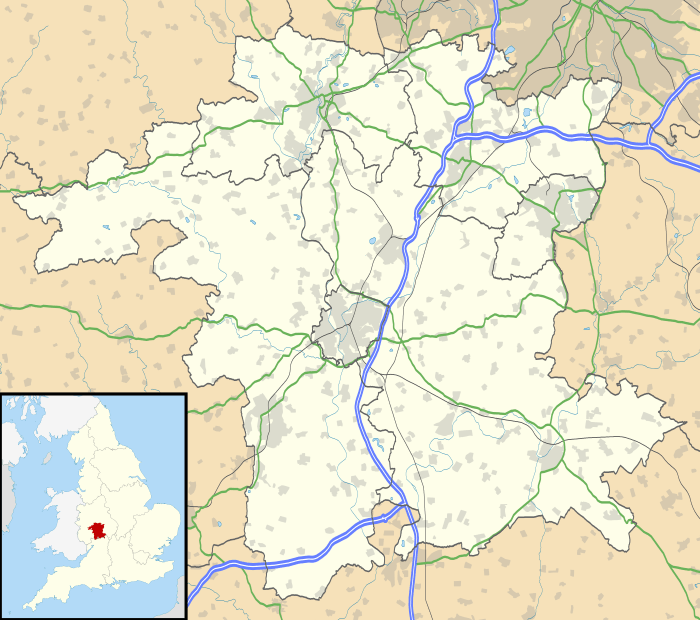Beoley
| Beoley | |
 St Leonard's parish church |
|
 Beoley |
|
| Population | 945 (parish, including Holt End) (2001 census)[1] |
|---|---|
| OS grid reference | SP0669 |
| – London | 95 miles (153 km) |
| Civil parish | Beoley |
| District | Bromsgrove |
| Shire county | Worcestershire |
| Region | West Midlands |
| Country | England |
| Sovereign state | United Kingdom |
| Post town | Redditch |
| Postcode district | B98 |
| Dialling code | 01527 |
| Police | West Mercia |
| Fire | Hereford and Worcester |
| Ambulance | West Midlands |
| EU Parliament | West Midlands |
| UK Parliament | Bromsgrove |
|
|
Coordinates: 52°19′26″N 1°54′22″W / 52.324°N 1.906°W
Beoley is a small village and much larger civil parish[2][3] just north of Redditch in the Bromsgrove District of Worcestershire, and adjoins Warwickshire to the east. The 2001 census recorded a parish population of 945,[1] most of whom live at Holt End. The parish adjoins Redditch's populous northern suburb of Church Hill,[4] and is also adjacent to the Civil Parishes of Alvechurch, Tanworth-in-Arden, Mappleborough Green and Wythall.[2]
Manor
The estates of the Benedictine Pershore Abbey included lands at Beoleahe from at least the 10th century when Edgar the Peaceful restored them to the monks in AD 972.[5] The Domesday Book of 1086 records that the abbey held 21 hides of land at Beolege and Yardley.[5] The de Beauchamp family of Elmley Castle, ancestors of William de Beauchamp, 9th Earl of Warwick, were mesne lords of the manor from the 12th century until about 1265, when they acquired the overlordship (superiority) from the abbey.[5] In the 13th century the toponym was variously rendered Boleye, Beleg or Buley.[5] The superiority of Beoley descended with the de Beauchamps until the death of Henry de Beauchamp, 1st Duke of Warwick in 1446, when it passed to his daughter Elizabeth, wife of George Nevill, 1st Baron Latimer.[5] This superiority is said to have remained with the Latimers until John Nevill, 4th Baron Latimer sold it in 1549.[5]
William Sheldon of Abberton, however, must have held a good part of the parish by feu as he was established at Balford Hall in Beoley in the reign of Edward IV (1460-1483). In addition he bought Benyt’s Place in that parish in 1488. Sheldon supported the Yorkists at the battle of Bosworth in 1485, and as a result of the definitive Lancastrian victory there he was deprived of his property, but it was restored to him before he died in 1517.[6] In his Inquisition Post Mortem (IPM), held at Pershore, it was said that Sheldon owned Balford Hall and seven other houses and 460 acres of land in Beoley, and even more elsewhere in Worcestershire and Warwickshire. In his will[7] he made bequests to the churches at Beoley and Abberton and to Pershore Abbey.
Sheldon was succeeded at Beoley by his son Ralph (d.1546), who was married to Philippa, daughter of Baldwin Heath of Ford Hall, Wootton Wawen.[5] Ralph was imprisoned in the Marshalsea in 1580 for recusancy but was released on medical grounds.[5] Ralph was succeeded at Beoley by his eldest son, William (b.c1500-1570), who possessed the manors of Weston, Warwickshire, Abberton (jointly with his brother Francis), and, by now, virtually the entire parish of Beoley (some 4000 acres). He was Receiver at the Court of Augmentations, Knight of the Shire for Worcestershire, and Sheriff of the same county. Around 1534, William Sheldon purchased 2,000 acres of land at Skilts, between Beoley and his mother’s home Ford Hall, which lands had been a grange of Studley Priory. His magnificent tomb is in Beoley parish church.
William Sheldon was succeeded by his son, another Ralph Sheldon (1537-1613), who was married to Anne, daughter of Sir Robert Throgmorton, Knt., of Coughton, who had attended the reception of Anne of Cleves. A Roman Catholic, Ralph Sheldon was a courtier at the Court of Queen Mary, and sometime a courier for Mary Queen of Scots between her place of confinement and Scotland. He is frequently mentioned in State Papers as a recusant, and in 1594 there is reference to an alleged premeditated rebellion in North Wales, "the chiefest aid for which is to come from Ralph Sheldon", and that he had sent an emissary to Louvain "with letters to Cardinal Allen." He is said to have been responsible for the construction of the great manor house at Weston Park in Warwickshire, another Sheldon estate in Long Compton parish. He was succeeded by his eldest son and heir Edward (1561-1643). Also a Royalist, in August 1636 King Charles 1st visited Warwick, and a day or two later went on "to Weston at Mr. Sheldon's house with great delight."
Edward's son and heir William Sheldon of Beoley (1589-1659), always resided at Weston Park (where he died). In 1611, he married Elizabeth, daughter of the recusant William Petre, 2nd Baron Petre.[8] Considered "a man of literary taste", Sheldon was a Royalist and at various times during the early years of the Civil War he was, in his turn, harassed as "a Popish delinquent".
In 1660 after the Restoration of the Monarchy Beoley was restored via Richard Sheldon to William's son, the famous antiquary Ralph Sheldon (1623-1684). He was married to Henrietta Maria, daughter of Thomas, 1st Viscount Savage, but had no issue.[5][9] Beoley now passed to a first cousin once removed, Ralph Sheldon, Lord of Beoley & Weston (1653-1720) who was married to Mary Anne, daughter of John Elliot of Gatacre Park, Shropshire. His estates passed to his eldest son and heir, Edward (1679-1746) and then to his eldest son William (1715-1780). His son Ralph Sheldon inherited Beoley in 1780, but by 1788 it was said to be heavily mortgaged and he sold the manor to a Thomas Holmes.[5] Holmes separated Beoley Hall (see below) and 300 acres (120 ha) of land from the rest of the manor and sold off the two lots to separate buyers.[5]
Beoley Hall
The Sheldons' main manor house at Beoley was originally Balford Hall. In September 1643 William Sheldon's manor house at Weston Park was ransacked, and cattle and goods taken away by soldiers "to a great value". The following December his manor house at Beoley was burnt to the ground, all his goods and cattle "plundered by the soldiers". In 1648 the Parliamentarian authorities sequestrated Beoley.[5] It was restored to the Sheldons in 1660 who had the present Beoley Hall built after the Restoration of the Monarchy, either late in the 17th[10] or early in the 18th century.[5] It is a neoclassical house on an H-shaped plan, originally entirely three-storeyed, built of brick and entirely stuccoed.[5]
In 1791 the new proprietor Thomas Holmes had the east wing rebuilt to plans by John Sanders, with two storeys built to the same height as the original three and a portico with four Tuscan columns.[10] On the south end of the east wing a bow window was added to the ground floor in 1791 and a matching window was subsequently added to the first floor above.[10] The main staircase is lit by a round skylight.[10]
In 1968 Beoley Hall was in poor condition[10] but since 1986 it has been a Grade II listed building.[11] It is now divided into apartments.[12]
Parish church
The oldest parts of the Church of England parish church of Saint Leonard[13] date from the early part of the 12th century[5] and include the chancel arch.[14] The south arcade dates from the early or middle part of the 13th century and the north arcade from about 1300.[14] The west tower is a Perpendicular Gothic[14] addition from about 1400[5] and the north aisle was also rebuilt in the Perpendicular style.[14]
The Sheldon Chapel on the north side was added for the recusant Ralph Sheldon in about 1580.[5] Its stone altar is said to be a gift from Pope Gregory XIII.[5] The church was restored in 1885 and the Sheldon Chapel was restored in 1891.[5]
The tower has a ring of eight bells.[15] The oldest is the tenor bell, cast in 1601 by Hugh Watts[15] of Leicester.[16] The seventh bell was cast in 1611 by one of the Newcombe family of bellfounders of Leicester. The fourth bell was cast in 1622 by Henry III Oldfield[15] of Nottingham.[16] Richard Sanders of Bromsgrove[16] cast the third bell in 1708[15] and the fifth bell in 1709.[15] John Rudhall of Gloucester[16] cast the seventh bell in 1789[15] which completed a ring of six.[5] In 1999 this was increased to eight by the addition of new treble and second bells cast by Whitechapel Bell Foundry.[15]
Amenities
The civil parish of Beoley has two public houses: the Cross and Bowling Green at Branson's Cross, and the Village Inn at Holt End.[17] The village has a first school[18] and a village hall.[19]
Notable people
- Edward Sheldon (1599–1687), translator of religious works from French.
- Ralph Sheldon (1623–1694), Royalist and antiquary, nephew of Edward.
- Mary Whateley (1738–1835), poet and playwright who wrote as Harriett Airy and Mary Darwall (her married name).
- Sarah Cooper (1848–1932), (née Gill), originator of Frank Cooper's Oxford marmalade.
- Sarah Falkland (living), a relief news presenter for BBC Midlands Today.
References
- 1 2 "Area selected: Bromsgrove (Non-Metropolitan District)". Neighbourhood Statistics: Full Dataset View. Office for National Statistics. Retrieved 8 March 2011.
- 1 2 "Beoley". Ordnance Survey. 19 July 2013. Retrieved 22 February 2014.
- ↑ "Bromsgrove District and West Mercia Police Parish Boundaries". Bromsgrove District Council. 2008. Retrieved 22 February 2014.
- ↑ "Extent of Beoley Civil Parish". Ordnance Survey. Retrieved 22 February 2014.
- 1 2 3 4 5 6 7 8 9 10 11 12 13 14 15 16 17 18 19 20 Willis-Bund & Page 1924, pp. 12–19
- ↑ Victoria County History, vol.iv, p.14, note 25.
- ↑ Prerogative Court of Canterbury, 35 Holder
- ↑ Barnard,E.A.B., The Sheldons, 1936, pg. 48
- ↑ Barnard, 1936, p.54-6.
- 1 2 3 4 5 Pevsner 1968, p. 81
- ↑ "Beoley Hall". National Heritage List for England. English Heritage. 16 July 1986. Retrieved 8 March 2011.
- ↑ "Beoley Hall, Beoley". British Listed Buildings. British Listed Buildings. Retrieved 8 March 2011.
- ↑ St Leonard's Church
- 1 2 3 4 Pevsner 1968, p. 80
- 1 2 3 4 5 6 7 Dawson, George; Pickford, Chris; Denton, Philip (3 December 2011). "Beoley S Leonard". Dove's Guide for Church Bell Ringers. Central Council of Church Bell Ringers. Retrieved 6 June 2013.
- 1 2 3 4 Dovemaster (31 October 2012). "Bell Founders". Dove's Guide for Church Bell Ringers. Central Council of Church Bell Ringers. Retrieved 6 June 2013.
- ↑ The Village Inn, Beoley Archived 24 November 2011 at the Wayback Machine.
- ↑ Beoley First School Archived 7 July 2011 at the Wayback Machine.
- ↑ Beoley Village Hall Archived 22 January 2011 at the Wayback Machine.
Sources
- Pevsner, Nikolaus (1968). Worcestershire. The Buildings of England. Harmondsworth: Penguin Books. pp. 80–81.
- Willis-Bund, J.W.; Page, W.H., eds. (1924). A History of the County of Worcester: Volume 4. Victoria County History. London. pp. 12–19.
| Wikimedia Commons has media related to Beoley. |